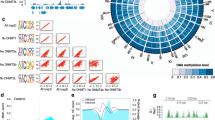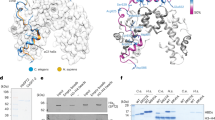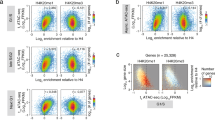Abstract
The organization of chromatin into higher-order structures influences chromosome function and epigenetic gene regulation. Higher-order chromatin has been proposed to be nucleated by the covalent modification of histone tails and the subsequent establishment of chromosomal subdomains by non-histone modifier factors. Here we show that human SUV39H1 and murine Suv39h1—mammalian homologues of Drosophila Su(var)3-9 and of Schizosaccharomyces pombe clr4—encode histone H3-specific methyltransferases that selectively methylate lysine 9 of the amino terminus of histone H3 in vitro. We mapped the catalytic motif to the evolutionarily conserved SET domain, which requires adjacent cysteine-rich regions to confer histone methyltransferase activity. Methylation of lysine 9 interferes with phosphorylation of serine 10, but is also influenced by pre-existing modifications in the amino terminus of H3. In vivo, deregulated SUV39H1 or disrupted Suv39h activity modulate H3 serine 10 phosphorylation in native chromatin and induce aberrant mitotic divisions. Our data reveal a functional interdependence of site-specific H3 tail modifications and suggest a dynamic mechanism for the regulation of higher-order chromatin.
This is a preview of subscription content, access via your institution
Access options
Subscribe to this journal
Receive 51 print issues and online access
$199.00 per year
only $3.90 per issue
Buy this article
- Purchase on Springer Link
- Instant access to full article PDF
Prices may be subject to local taxes which are calculated during checkout






Similar content being viewed by others
References
Strahl, B. D. & Allis, C. D. The language of covalent histone modifications. Nature 403, 41– 45 (2000).
Grunstein, M. Yeast heterochromatin: regulation of its assembly and inheritance by histones. Cell 93, 325–328 (1998).
Turner, B. M. Histone acetylation as an epigenetic determinant of long-term transcriptional competence. Cell. Mol. Life Sci. 54, 21– 31 (1998).
Karpen, G. & Allshire, R. C. The case for epigenetic effects on centromere identity and function. Trends Genet. 13, 489–496 (1997).
Wei, Y., Lanlan, Y., Bowen, J., Gorovsky, M. A. & Allis, C. D. Phosphorylation of histone H3 is required for proper chromosome condensation and segregation. Cell 97, 99–109 (1999).
Chen, D. et al. Regulation of transcription by a protein methyltransferase. Science 284, 2174–2177 ( 1999).
Strahl, B. D., Ohba, R., Cook, R. G. & Allis, C. D. Methylation of histone H3 at lysine 4 is highly conserved and correlates with transcriptionally active nuclei in Tetrahymena. Proc. Natl Acad. Sci. USA 96, 14967–14972 ( 1999).
Sassone-Corsi, P. et al. Requirement of Rsk-2 for epidermal growth factor-activated phosphorylation of histone H3. Science 285, 886–891 (1999).
Hsu, J.-Y. et al. Mitotic phosphorylation of histone H3 is governed by Ipl1/aurora kinase and Glc7/PP1 phosphatase in budding yeast and nematodes. Cell 102, 1–20 ( 2000).
Reuter, G. & Spierer, P. Position-effect variegation and chromatin proteins. BioEssays 14, 605– 612 (1992).
Allshire, R. C., Nimmo, E. R., Ekwall, K., Javerzat, J. P. & Cranston, G. Mutations derepressing silent centromeric domains in fission yeast disrupt chromosome segregation. Genes Dev. 9, 218–233 (1995).
Wallrath, L. L. Unfolding the mysteries of heterochromatin. Curr. Opin. Genet. Dev. 8, 147–153 ( 1998).
De Rubertis, F. et al. The histone deacetylase RPD3 counteracts genomic silencing in Drosophila and yeast. Nature 384, 589–591 (1996).
Grewal, S. I., Bonaduce, M. J. & Klar, A. J. Histone deacetylase homologs regulate epigenetic inheritance of transcriptional silencing and chromosome segregation in fission yeast. Genetics 150, 563– 576 (1999).
Baksa, K. et al. Mutations in the protein phosphatase 1 gene at 87B can differentially affect suppression of position effect variegation and mitosis in Drosophila melanogaster. Genetics 135, 117– 125 (1993).
Larsson, J., Zhang, J. & Rasmuson-Lestander, Å. Mutations in the Drosophila melanogaster gene encoding S-adenosyl methionine suppress position-effect variegation. Genetics 143, 887–896 (1996).
Eissenberg, J. C., Morris, G. D., Reuter, G. & Hartnett, T. The heterochromatin-associated protein HP-1 is an essential protein in Drosophila with dosage-dependent effects on position-effect variegation. Genetics 131, 345–352 (1992).
Cléard, F., Delattre, M. & Spierer, P. SU(VAR)3-7, a Drosophila heterochromatin-associated protein and companion of HP1 in the genomic silencing of position-effect variegation. EMBO J. 16, 5280–5288 (1997).
Tschiersch, B. et al. The protein encoded by the Drosophila position-effect variegation suppressor gene Su(var)3-9 combines domains of antagonistic regulators of homeotic gene complexes. EMBO J. 13, 3822–3831 (1994).
Schotta, G. & Reuter, G. Controlled expression of tagged proteins in Drosophila using a new modular P-element vector system. Mol. Gen. Genet. 262, 916–920 (2000).
Henikoff, S. in Epigenetic Mechanisms of Gene Regulation (eds Russo, V. A. E., Martienssen, R. A. & Riggs, A. D) 319–334 (CSHL, New York, 1996).
Ivanova, A. V., Bonaduce, M. J., Ivanov, S. V. & Klar, A. J. S. The chromo and SET domains of the Clr4 protein are essential for silencing in fission yeast. Nature Genet. 19, 192– 195 (1998).
Ekwall, K. et al. Mutations in the fission yeast silencing factors clr4+ and rik1+ disrupt the localisation of the chromo domain protein Swi6p and impair centromere function. J. Cell Sci. 109, 2637–2648 (1996).
Aagaard, L. et al. Functional mammalian homologues of the Drosophila PEV modifier Su(var)3-9 encode centromere-associated proteins which complex with the heterochromatin component M31. EMBO J. 18, 1923–1938 (1999).
Aasland, R. & Stewart, A. F. The chromo shadow domain, a second chromodomain in heterochromatin-binding protein1, HP1. Nucleic Acids Res. 23, 3168–3173 (1995).
Koonin, E. V., Zhou, S. & Lucchesi, J. C. The chromo superfamily: new members, duplication of the chromo domain and possible role in delivering transcription regulators to chromatin. Nucleic Acids Res. 23, 4229 –4232 (1995).
Jenuwein, T., Laible, G., Dorn, R. & Reuter, G. SET-domain proteins modulate chromatin domains in eu- and heterochromatin. Cell. Mol. Life Sci. 54, 80–93 ( 1998).
Ball, L. J. et al. Structure of the chromatin binding (chromo) domain from mouse modifier protein 1. EMBO J. 16, 2473– 2481 (1997).
Platero, J. S., Harnett, T. & Eissenberg, J. C. Functional analysis of the chromo domain of HP-1 . EMBO J. 14, 3977– 3986 (1995).
Jones, R. S. & Gelbart, W. M. The Drosophila Polycomb -group gene Enhancer of zeste contains a region with sequence similarity to trithorax. Mol. Cell. Biol. 13, 6357–6366 (1993).
Stassen, M. J., Bailey, D., Nelson, S., Chinwalla, V. & Harte, P. J. The Drosophila trithorax protein contains a novel variant of the nuclear receptor type DNA binding domain and an ancient conserved motif found in other chromosomal proteins. Mech. Dev. 52, 209–223 ( 1995).
Schultz, J., Copley, R. R., Doerks, T., Ponting, C. P. & Bork, P. SMART: a web-based tool for the study of genetically mobile domains. Nucleic Acids Res. 28 , 231–234 (2000).
Klein, R. R. & Houtz, R. L. Cloning and developmental expression of pea ribulose-1,5-biphosphate carboxylase/oxygenase large subunit N-methyltransferase. Plant Mol. Biol. 27, 249– 261 (1995).
Zheng, Q., Simel, E., Klein, P., Royer, M. & Houtz, R. L. Expression, purification, and characterization of recombinant ribulose-1,5-biphosphate carboxylase/oxygenase large subunit Nε-methyltransferase. Protein Exp. Purif. 14, 104–112 (1998).
Melcher, M. et al. Structure–function analysis of SUV39H1 reveals a dominant role in heterochromatin organization, chromosome segregation and mitotic progression. Mol. Cell. Biol. 20, 3728– 3741 (2000).
Laible, G., et al. Mammalian homologues of the Polycomb-group gene Enhancer of zeste mediate gene silencing in Drosophila heterochromatin and at S. cerevisae telomeres. EMBO J. 16, 3219–3232 (1997).
Tkachuk, D. C., Kohler, S. & Cleary, M. L. Involvement of a homolog of Drosophila trithorax by 11q23 chromosomal translocations in acute leukemias. Cell 71, 691–700 ( 1992).
Sullivan, K. F., Hechenberger, M. & Masri, K. Human CENP-A contains a histone H3 related histone fold domain that is required for targeting to the centromere. J. Cell Biol. 127, 581–592 ( 1994).
Pehrson, J. R. & Fried, V. A. MacroH2A, a core histone containing a large nonhistone region. Science 257, 1398–1400 (1992).
Hendzel, M. J. et al. Mitosis-specific phosphorylation of histone H3 initiates primarily within pericentromeric heterochromatin during G2 and spreads in an ordered fashion coincident with mitotic chromosome condensation. Chromosoma 106, 348–360 ( 1997).
Martzen, M. R. et al. A biochemical genomics approach for identifying genes by the activity of their products. Science 286, 1153–1155 (1999).
Cui, X. et al. Association of SET domain and myotubularin-related proteins modulates growth control. Nature Genet. 18, 331– 337 (1998).
Firestein, R., Cui, X., Huie, P. & Cleary, M. L. SET domain-dependent regulation of transcriptional silencing and growth control by SUV39H1, a mammalian ortholog of Drosophila Su(var)3-9. Mol. Cell. Biol. 20, 4900–4909 (2000).
Murzina, N., Verrault, A., Laue, E. & Stillman, B. Heterochromatin dynamics in mouse cells: interaction between chromatin assembly factor1 and HP1 proteins. Mol. Cell 4, 529– 540 (1999).
Birney, E., Thompson, J. D. & Gibson, T. J. PairWise and SearchWise: finding the optimal alignment in a simultaneous comparison of a protein profile against all DNA translation frames. Nucleic Acids Res. 24, 2730– 2739 (1996).
Eddy, S. R. Profile hidden Markov models. Bioinformatics 14, 755–763 (1998).
Altschul, S. F. et al. Gapped BLAST and PSI-BLAST: a new generation of protein database search programs. Nucleic Acids Res. 17, 3389–33402 (1997).
Frishman, D. & Argos, P. Seventy-five percent accuracy in protein secondary structure prediction. Proteins Struct. Funct. Genet. 27, 329–335 ( 1997).
Xu, X. et al. Centrosome amplification and a defective G2-M cell cycle checkpoint induce genetic instability in BRCA1 exon 11 isoform-deficient cells. Mol. Cell 3, 389–395 (1999).
Acknowledgements
We would like to thank M. Cleary for providing a partial HRX cDNA, R. Allshire for the Clr4 cDNA, I. Gorny for peptide synthesis and R. G. Cook for automated sequencing of the H3 N-terminal peptide. During the course of this work, E. V. Koonin and L. Aravind have independently discovered homology of the SET domain with plant methyltransferases. We acknowledge M. Doyle for the contribution to the Suv39HZ knockout and thank K. Nasmyth and M. Busslinger for helpful comments and critical reading of the manuscript. Research in the laboratory of C.D.A. is funded by grants from the NIH to C.D.A. and B.D.S. Z.-W.S. is supported by a postdoctoral cancer training grant from the University of Virginia Cancer center. Research in the laboratory of T.J. is supported by the IMP, the Austrian Research Promotion Fund and the Vienna Business Agency.
Author information
Authors and Affiliations
Corresponding author
Rights and permissions
About this article
Cite this article
Rea, S., Eisenhaber, F., O'Carroll, D. et al. Regulation of chromatin structure by site-specific histone H3 methyltransferases . Nature 406, 593–599 (2000). https://doi.org/10.1038/35020506
Received:
Accepted:
Issue Date:
DOI: https://doi.org/10.1038/35020506
This article is cited by
-
Keep quiet: the HUSH complex in transcriptional silencing and disease
Nature Structural & Molecular Biology (2024)
-
In silico characterization of five novel disease-resistance proteins in Oryza sativa sp. japonica against bacterial leaf blight and rice blast diseases
3 Biotech (2024)
-
Methylation across the central dogma in health and diseases: new therapeutic strategies
Signal Transduction and Targeted Therapy (2023)
-
TNRC18 engages H3K9me3 to mediate silencing of endogenous retrotransposons
Nature (2023)
-
Epigenetic regulation in the tumor microenvironment: molecular mechanisms and therapeutic targets
Signal Transduction and Targeted Therapy (2023)
Comments
By submitting a comment you agree to abide by our Terms and Community Guidelines. If you find something abusive or that does not comply with our terms or guidelines please flag it as inappropriate.



